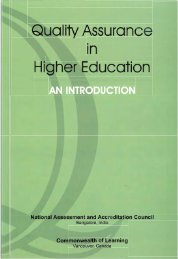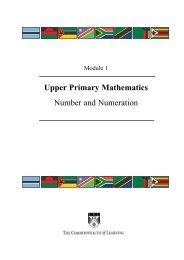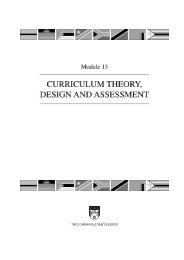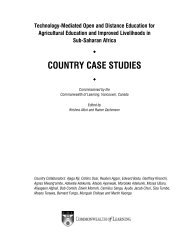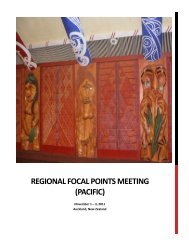Upper Primary Mathematics Fractions - Commonwealth of Learning
Upper Primary Mathematics Fractions - Commonwealth of Learning
Upper Primary Mathematics Fractions - Commonwealth of Learning
Create successful ePaper yourself
Turn your PDF publications into a flip-book with our unique Google optimized e-Paper software.
Equivalent Fraction Concepts<br />
Pupils should have a sound knowledge <strong>of</strong> equivalent fractions before learning<br />
the four operations on common fractions especially addition and subtraction.<br />
Two fractions are equivalent if they are representations for the same amount.<br />
To acquire the conceptual understanding <strong>of</strong> equivalent fractions pupils should<br />
use models such as area, length, and sets to discover different names for<br />
models <strong>of</strong> fractions.<br />
Practice Activity 7: Area Models<br />
Paper folding can be used to effectively model the concept <strong>of</strong> equivalent<br />
fractions. Fold a sheet <strong>of</strong> paper into halves or thirds. Unfold and colour a<br />
fraction <strong>of</strong> the paper. Write the fraction. Now refold and fold one more time<br />
(Figure 1.7). Before opening, guess how many parts will be in the whole<br />
sheet and how many will be coloured. Open the paper. What fraction names<br />
can be given to the shaded region? Is the name still the same? Why? What<br />
about the amount <strong>of</strong> the shaded part, is it still the same? Why? Record the<br />
equivalent fractions you have generated.<br />
Figure 1.7<br />
Rectangle Slicing: Multiply-by-1-method<br />
We would like you to develop an equivalent fraction algorithm using<br />
rectangle slicing with your pupils.<br />
Put pupils in cooperative learning groups. Give them papers. Have them draw<br />
several equal squares whose sides are 8 cm. Have them shade the same<br />
fraction in several different squares vertically subdividing lines. Next, pupils<br />
slice each rectangle horizontally into different fractional parts, as shown in<br />
Figure 1.8. Help pupils focus on the products involved by having them write<br />
top and bottom numbers as a product in the fraction.<br />
1<br />
Start with each square showing<br />
2<br />
1<br />
2<br />
=<br />
1 × 2<br />
=<br />
2 × 2<br />
2<br />
4<br />
Figure 1.8: A model for the equivalent fractions<br />
Continues on next page<br />
1<br />
2<br />
=<br />
1 × 6<br />
=<br />
6<br />
2 × 6 12<br />
Module 2: Unit 1 10<br />
Common <strong>Fractions</strong>



